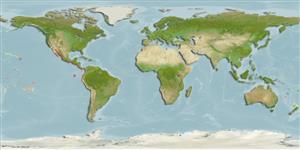Environment: milieu / climate zone / depth range / distribution range
Ekologi
laut berasosiasi dengan karang; kisaran kedalaman 5 - 25 m (Ref. 9324). Tropical
Eastern Pacific: Gulf of California to Islas Lobos de Afuera, Peru, including the Galapagos Islands.
Size / Weight / umur
Maturity: Lm ? range ? - ? cm
Max length : 61.0 cm TL jantan/; (Ref. 5590); common length : 35.0 cm TL jantan/; (Ref. 57763)
deskripsi pendek
Morfologi | Morfometrik
Head and jaws very much compressed; body tapering posteriorly. Body depth at the middle about 1/13 of the entire length; the head about 1/7, measured to the branchial orifice. Jaws very narrow, sharp-pointed and equal. Gape deeply cleft. Teeth compressed at the sides, very sharp, slightly hooked and pointing backwards. Two tubular orifices above the eyes and two at the extremity of the snout. Distance of eyes from the end of the snout about twice the eye diameter. Branchial orifice and eyes of same size. Dorsal fin thick and fleshy. Color is fine dark purplish brown, with yellow circular spots; the spots mostly small. (Ref. 3157).
Often seen in shallow water. Remains under cover in rocky crevices during the day. Feeds mainly at night on crustaceans and fishes (Ref. 6852). Constantly opens and closes it mouth, an action required for respiration, not a threat (Ref. 5227).
Life cycle and mating behavior
Kematangan | Reproduksi, perkembang biakan | Pemijahan | telur-telur | Fecundity | Larva
Merlen, G., 1988. A field guide to the fishes of Galapagos. Wilmot Books, London, England 60 p. (Ref. 5590)
Status IUCN Red List (Ref. 130435)
ancaman kepada manusia
Harmless
penggunaan manusia
informasi lanjut
Nama-nama umumSinonim (persamaan)metabolismePemangsaEkotoksikologiReproduksi, perkembang biakanKematanganPemijahanSpawning aggregationFecunditytelur-telurpekembangan telor
Umur / SaizPertumbuhanpanjang-beratpanjang-panjangukuran frekuensiMorfometrikMorfologiLarvaDinamika larvapemulihanKelimpahanBRUVS
AcuanBudidaya airprofil budidaya airStrainGenetikaElectrophoresesDiturunkanPenyakit-penyakitPengolahanNutrientsMass conversion
mitraGambarStamps, Coins Misc.Suara-suaraCiguateraKecepatanTipe renangArea insangOtolithsOtakPenglihatan / visi
Alat, peralatan
laporan khas
muat turun XML
Sumber internet
Estimates based on models
Preferred temperature (Ref.
123201): 22.3 - 29.1, mean 26.7 °C (based on 244 cells).
Phylogenetic diversity index (Ref.
82804): PD
50 = 0.5010 [Uniqueness, from 0.5 = low to 2.0 = high].
Bayesian length-weight: a=0.00050 (0.00025 - 0.00101), b=3.26 (3.10 - 3.42), in cm total length, based on LWR estimates for this (Sub)family-body shape (Ref.
93245).
Trophic level (Ref.
69278): 3.9 ±0.61 se; based on food items.
Daya lenting (Ref.
120179): sedang, Waktu penggandaan populasi minimum 1.4 - 4.4 tahun (Preliminary K or Fecundity.).
Fishing Vulnerability (Ref.
59153): Moderate vulnerability (44 of 100).
Nutrients (Ref.
124155): Calcium = 39.1 [21.5, 70.3] mg/100g; Iron = 0.476 [0.287, 0.993] mg/100g; Protein = 18.8 [16.5, 21.3] %; Omega3 = 0.105 [0.047, 0.293] g/100g; Selenium = 34.1 [19.2, 69.0] μg/100g; VitaminA = 75.8 [22.5, 227.7] μg/100g; Zinc = 1.02 [0.73, 1.41] mg/100g (wet weight);
